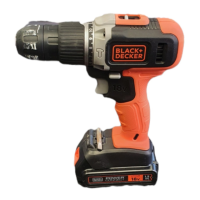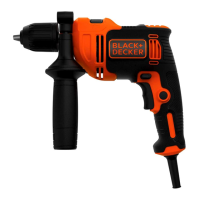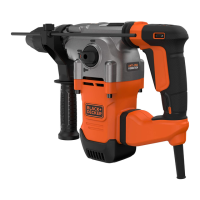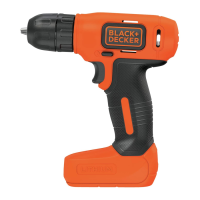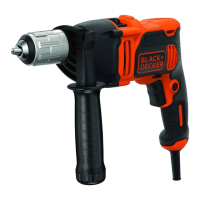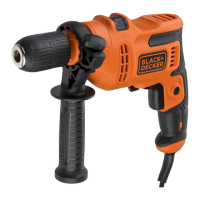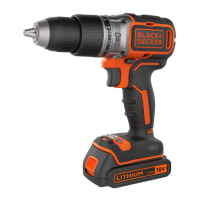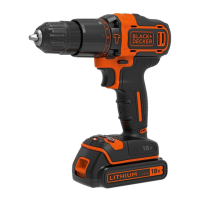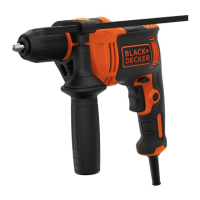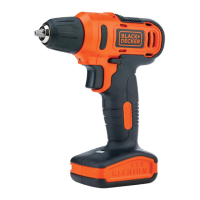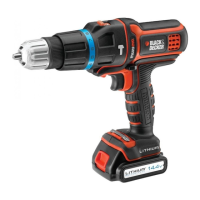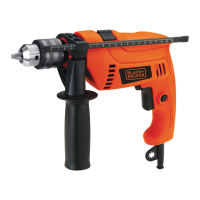ENGLISH
6
4. The completion of charge is indicated by the green LED
remaining on continuously. The pack is fully charged
and may be used at this time or left on thecharger.
Leaving the battery in the charger
The charger and battery pack can be left connected with
the green LED glowing indefinitely. The charger will keep
the battery pack fresh and fully charged.
Charger Cleaning Instructions
WARNING: Shock hazard. Disconnect the charger
from the AC outlet before cleaning. Dirt and grease
may be removed from the exterior of the charger using
a cloth or soft non-metallic brush. Do not use water or
any cleaningsolutions.
Important Charging Notes
1. Longest life and best performance can be obtained if
the battery pack is charged when the air temperature is
between 65°F and 75°F (18° – 24°C). DO NOT charge
the battery pack in an air temperature below +40°F
(+4.5°C), or above +104°F (+40°C). This is important
and will prevent serious damage to the batterypack.
2. The charger and battery pack may become warm to the
touch while charging. This is a normal condition, and
does not indicate a problem. To facilitate the cooling of
the battery pack after use, avoid placing the charger or
battery pack in a warm environment such as in a metal
shed or an uninsulatedtrailer.
3. If the battery pack does not charge properly:
a. Check operation of receptacle by plugging in a lamp
or other appliance;
b. Check to see if receptacle is connected to a light switch
which turns power off when you turn out the lights;
c. Move the charger and battery pack to a location
where the surrounding air temperature is
approximately 65°F – 75°F (18° – 24°C);
d. If charging problems persist, take the tool, battery
pack and charger to your local servicecenter.
4. The battery pack should be recharged when it fails to
produce sufficient power on jobs which were easily
done previously. DO NOT CONTINUE to use under these
conditions. Follow the charging procedure. You may
also charge a partially used pack whenever you desire
with no adverse effect on the batterypack.
5. Foreign materials of a conductive nature such as, but
not limited to, grinding dust, metal chips, steel wool,
aluminum foil, or any buildup of metallic particles
should be kept away from charger cavities. Always
unplug the charger from the power supply when there
is no battery pack in the cavity. Unplug the charger
before attempting toclean.
6. Do not freeze or immerse the charger in water or any
otherliquid.
Storage Recommendations
1. The best storage place is one that is cool and dry, away
from direct sunlight and excess heat orcold.
2. For long storage, it is recommended to store a fully
charged battery pack in a cool dry place out of the
charger for optimalresults.
NOTE: Battery packs should not be stored completely
depleted of charge. The battery pack will need to be
recharged beforeuse.
SAVE THESE INSTRUCTIONS FOR
FUTURE USE
THIS PRODUCT USES THE BATTERY
AND CHARGER LISTED IN THE CHART
BELOW.
Description Catalog
Number
20V Max* Lithium-Ion
Battery:
ʵ LBXR20
ʵ LB20
ʵ LBX20
ʵ LBXR20BT
20V Max* Lithium-Ion
Battery Charger:
ʵ LCS20
ʵ LCS201
ʵ LCS1620
2 Amp Fast Charger: ʵ L2AFC
ʵ L2AFCBST
ʵ LCS200
COMPONENTS (FIG. A)
WARNING: Never modify the power tool or any part
of it. Damage or personal injury couldresult.
Refer to Figure A at the beginning of this manual for a
complete list ofcomponents.
Intended Use
The drill is designed for drilling and
screwdrivingapplications.
DO NOT use under wet conditions or in presence of
flammable liquids orgases.
This drill is a power tool. DO NOT let children come
into contact with the tool. Supervision is required when
inexperienced operators use thistool.
Trigger Switch
(Fig. B)
• The drill is turned ON and OFF by squeezing and
releasing the variable speed trigger switch
1
.
• The more the trigger is depressed, the higher the speed
of the drill.
Selecting the Direction of Rotation
(Fig. B)
For drilling and for tightening screws, use forward
(clockwise) rotation. For loosening screws or removing a
jammed drill bit, use reverse (counterclockwise) rotation.
WARNING: Never change the direction of rotation
while the motor is running.
A forward/reverse control button
2
determines the
direction of the tool and also serves as a lock off button.
• To select forward rotation, push the forward/reverse
slider
2
to the left (when viewed from the chuck end).
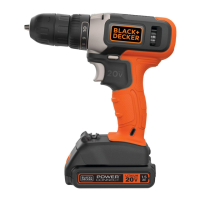
